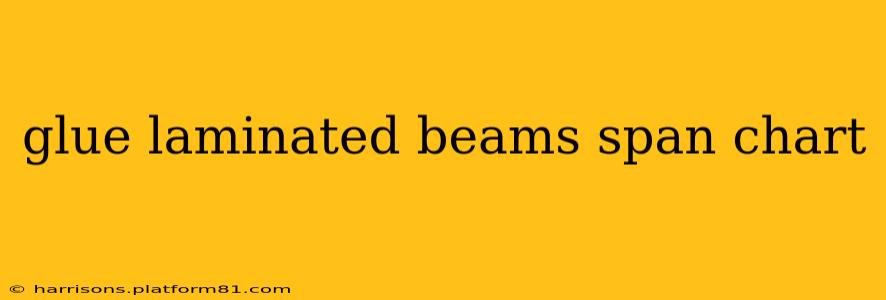Glue laminated timber (glulam) beams offer exceptional strength and versatility for a wide range of construction projects. Their ability to span significant distances makes them a popular choice for everything from residential roofs to large commercial structures. However, understanding the appropriate span capabilities for a glulam beam is crucial for structural integrity and safety. This comprehensive guide explores glulam beam span charts, factors influencing span capacity, and essential considerations for selecting the right beam for your project.
What is a Glulam Beam Span Chart?
A glulam beam span chart is a visual reference tool that shows the maximum allowable span for different sizes and grades of glulam beams under specific load conditions. These charts usually present data in tabular or graphical format, allowing engineers and builders to quickly determine the appropriate beam size for a given project. The charts typically consider factors like the beam's dimensions (depth, width, length), the type of wood used, the load it will carry (dead load and live load), and the desired safety factor. It's crucial to remember that these charts are guidelines, and a professional structural engineer should always be consulted for final design and verification.
Factors Affecting Glulam Beam Span Capacity
Several key factors influence the maximum span a glulam beam can achieve:
-
Beam Size (Depth and Width): Larger beams, with greater depth and width, naturally support heavier loads and longer spans. The depth is the most significant factor influencing span capacity.
-
Wood Species and Grade: Different wood species possess varying strength properties. Higher grades of glulam, indicating superior quality and strength, can support longer spans than lower grades. The specific grade and species are typically specified in the span chart itself.
-
Load Conditions: The total load the beam must support is a major determinant of its required size and therefore its span capacity. This load encompasses both dead load (the weight of the beam itself and any permanently attached elements) and live load (variable loads such as snow, people, or furniture).
-
Span Type: The type of support at each end of the beam (simple support, cantilever, continuous) influences the bending stresses and therefore the allowable span.
-
Spacing of Supports: The distance between supports directly impacts the bending moment and hence the span capacity.
How to Use a Glulam Beam Span Chart (and Why You Shouldn't Rely Solely on It)
While glulam beam span charts provide a convenient overview, their proper interpretation requires careful consideration:
-
Identify Your Load Conditions: Accurately estimate both dead and live loads for your specific application. Overestimating or underestimating the loads can have serious consequences.
-
Determine Support Type: Clearly define the type of support at each end of the beam (e.g., simple support, fixed support).
-
Select the Appropriate Chart: Use a span chart specific to the species and grade of glulam timber you intend to use.
-
Locate the Correct Beam Size: Find the intersection of your chosen load and span on the chart to determine the appropriate beam size.
Important Note: While span charts offer guidance, they are not a replacement for professional engineering calculations. Always consult a structural engineer to ensure the chosen beam meets all relevant building codes and safety standards. They will account for various factors not always explicitly shown on a simplified chart.
Where Can I Find Glulam Beam Span Charts?
Glulam manufacturers and suppliers often provide span charts on their websites or in their product catalogs. You can also find relevant information in structural engineering handbooks and design guides. However, remember that these charts are general guidelines.
What Are the Different Types of Glulam Beams?
Glulam beams are available in various sizes, shapes, and grades, allowing for flexibility in design and structural needs. Common shapes include rectangular, I-beams, and curved beams. The grade of the glulam indicates its strength properties, with higher grades signifying greater strength and load-bearing capacity.
What are the advantages of using glulam beams?
Glulam beams offer many advantages, including:
- High Strength-to-Weight Ratio: They are strong and lightweight compared to many other structural materials.
- Long Spans: They can span significant distances, minimizing the need for intermediate supports.
- Design Flexibility: They can be manufactured in various shapes and sizes to suit specific design requirements.
- Sustainability: Glulam is made from renewable wood resources.
- Aesthetic Appeal: The natural beauty of wood adds visual interest to a structure.
Conclusion
Glue laminated beams are a versatile and efficient structural solution for various applications. While glulam beam span charts provide valuable initial guidance, it is absolutely critical to consult a qualified structural engineer to ensure the safe and appropriate design of any project involving these beams. Understanding the factors influencing span capacity and using the charts responsibly is crucial for ensuring structural integrity and safety. Remember, safety should always be the top priority.
